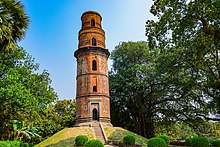Malik Andil Habshi (Bengali: মালিক আন্দিল হাবশী), better known by his regnal title Saifuddin Firoze Shah (Bengali: সাইফউদ্দীন ফিরোজ শাহ, Persian: سیف الدین فیروز شاه) was the second "Habshi" ruler of the Bengal Sultanate's Habshi dynasty. He was a former army commander of the Sultanate's Ilyas Shahi dynasty.[2]
| Saifuddin Firoze Shah | |||||
|---|---|---|---|---|---|
 The Firoz Minar in Gauda | |||||
| 15th Sultan of Bengal | |||||
| Reign | 1487–1489 | ||||
| Predecessor | Barbak Shah II | ||||
| Successor | Mahmud Shah II | ||||
| Born | Malik Andil | ||||
| Died | 1489 Bengal Sultanate | ||||
| |||||
| House | Habshi | ||||
| Religion | Islam | ||||
Biography
editAndil was an army commander of the Ilyas Shahi dynasty who seized power after killing the rebel Sultan, Barbak Shah II, in 1487. After claiming the throne, he styled himself as Saifuddin Firuz Shah. It is said that Andil was an eunuch.[3]
He is often considered as the real founder of the Habshi rule in Bengal as the previous Shahzada Barbak only ruled for a few months.[4] This is reinforced in an inscription found in Garh Jaripa in Sreebardi, Sherpur, where he ordered the construction of someone's tomb and referred to himself as Sultan al-Ahad (the first Sultan). The four corners of the specific tomb each bore the names of the Rashidun caliphs and the inscription sent blessings upon the Islamic prophet Muhammad, his daughter Fatimah and her two sons Hasan and Husayn. This inscription now can be found in the Indian Museum, Kolkata.[1] Firuz Shah minted coins during his reign which mentions the historical town of Mahmudabad.[5]
He is described as a patron of architecture and calligraphy in Bengal. He ordered Majlis Sa'd to build a mosque in Maldah. On 18 January 1489, he ordered Mukhlis Khan to construct a ten-domed mosque in Goamatli, Maldah. In the same year, he also ordered Ulugh Ali Zafar Khan to construct a mosque in Kalna.[1][6] It is also considered that the Bokainagar and Tajpur forts were established by Majlis Khan Humayun during his expedition to Kamarupa, under the orders of Firuz Shah.[7] He also built the Katra mosque in Maldah and the inscription contains authentic Tughra calligraphy.[8]
His most famous architecture is the Firuz Minar. Named after himself, it is a large five-storeyed tower situated in Gauda.[9] The construction started in 1485 before his reign, but was completed in 1489 to commemorate his victories in the battlefield.[10][11] According to tradition, he threw the chief architect from the topmost storey, as he was not satisfied with the tower's height and wanted it to be taller.[12]
Death
editHis rule lasted two years until his death in 1489, and was succeeded by his adopted son, Mahmud Shah II.[2] Most historians consider that he died of natural causes, while some such as Ghulam Husain Salim and Jadunath Sarkar theorized that he was killed by one of the Abyssinian palace-guards.[3]
See also
editReferences
edit- ^ a b c Ahmad Hasan Dani (20 April 2024). "Analysis of the Inscriptions". Asiatic Society Of Pakistan Vol-ii. pp. 38–41.
- ^ a b KingListsFarEast
- ^ a b Dasgupta, Biplab (2005). "Political History". European Trade and Colonial Conquest, Volume 1. Anthem Press. p. 129.
- ^ Abidde, Sabella Ogbobode; Abegunrin, Olayiwola (15 June 2016). "Blacks in Asia". Pan-Africanism in Modern Times: Challenges, Concerns, and Constraints. Lexington Books. p. 159.
- ^ Muhammad Akhtaruzzaman (2012). "Mint Towns". In Sirajul Islam; Miah, Sajahan; Khanam, Mahfuza; Ahmed, Sabbir (eds.). Banglapedia: the National Encyclopedia of Bangladesh (Online ed.). Dhaka, Bangladesh: Banglapedia Trust, Asiatic Society of Bangladesh. ISBN 984-32-0576-6. OCLC 52727562. OL 30677644M. Retrieved 28 December 2024.
- ^ Bhatt, Purnima Mehta. "Sidis in Bengal". The African Diaspora in India: Assimilation, Change and Cultural Survivals. p. 43.
- ^ Shahnaj Husne Jahan (2012). "Bokainagar Fort". In Sirajul Islam; Miah, Sajahan; Khanam, Mahfuza; Ahmed, Sabbir (eds.). Banglapedia: the National Encyclopedia of Bangladesh (Online ed.). Dhaka, Bangladesh: Banglapedia Trust, Asiatic Society of Bangladesh. ISBN 984-32-0576-6. OCLC 52727562. OL 30677644M. Retrieved 28 December 2024.
- ^ PIS Mustafizur Rahman (2012). "Muslim Calligraphy". In Sirajul Islam; Miah, Sajahan; Khanam, Mahfuza; Ahmed, Sabbir (eds.). Banglapedia: the National Encyclopedia of Bangladesh (Online ed.). Dhaka, Bangladesh: Banglapedia Trust, Asiatic Society of Bangladesh. ISBN 984-32-0576-6. OCLC 52727562. OL 30677644M. Retrieved 28 December 2024.
- ^ ABM Husain (2012). "Firuz Minar". In Sirajul Islam; Miah, Sajahan; Khanam, Mahfuza; Ahmed, Sabbir (eds.). Banglapedia: the National Encyclopedia of Bangladesh (Online ed.). Dhaka, Bangladesh: Banglapedia Trust, Asiatic Society of Bangladesh. ISBN 984-32-0576-6. OCLC 52727562. OL 30677644M. Retrieved 28 December 2024.
- ^ "Places to visit". Retrieved 24 March 2019.
- ^ "Firoz Minar". ASI Kolkata. Retrieved 24 March 2019.
- ^ "ইতিহাসের দেশে ২ / দাখিল দরওয়াজা, ফিরোজ মিনার, বাইশগজী দেওয়াল" (in Bengali). Khabar Online. 24 May 2018. Retrieved 24 March 2019.